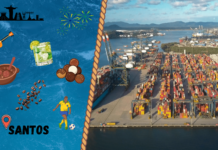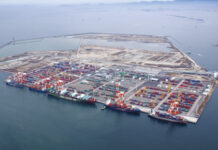
Indian shippers, already roiled by ocean capacity shortages and soaring freight rate levels, are bracing for a prolonged schedule disruption on their most-sought after US East Coast connection.
Amid excessive congestion plaguing North American ports that inevitably end up in considerably longer round-trip times for vessel operators, the Indamex (India-America Express) Service is temporarily dropping calls to Savannah and Charleston from its declared/regular itinerary.
A total of nine westbound sailings — due to depart from Port Qasim
(Karachi) in March and April – will be readjusted to cover the delays and maintain a weekly sailing frequency. The changed Indamex rotation will be Port Qasim, Nhava Sheva (JNPT), Mundra, Damietta, New York, Norfolk, Port Said, Jeddah and Port Qasim.
The weekly Indamex is a vessel-sharing agreement (VSA) between Hapag-Lloyd, CMA CGM, Ocean Network Express (ONE) and OOCL.
“This change is caused by the ongoing congestion at these ports, and is relevant to maintain the schedule reliability with a weekly sailing,” Hapag-Lloyd said in a trade notice.
The consortium intends to make up for the loss of service reliability by diverting some of the Savannah and Charleston cargo onto the Indamex 2, a supplementary loop Hapag-Lloyd and CMA CGM together introduced in September last year on the same trade route.
The sibling loop (Indamex 2) calls at Port Qasim/Karachi, Mundra, Nhava Sheva/JNPT, Norfolk, Savannah, New York, and back to Port Qasim, deploying a fleet of eight vessels – five from Hapag-Lloyd and three from CMA CGM.
The Indamex was the first direct, express service from West India to USEC, having entered the market in 2000, and, as such, the incoming void port calls will be a bigger blow for regular shippers and freight forwarders already working on their shipment forecasts and loading plans.
Further, elevated sourcing demand from US importers makes that disruption even more concerning for the industry. According to the latest official data, two-way trade between India and the US hit a new high in 2021, growing 45% year-over-year to US$113 billion.
That was a strong turnaround after 2020 trade volumes slid to some US$78 billion from a level of US$92 billion in 2019 in the wake of Covid-induced disruption and economic downturn.
Given that booming demand, Indian exporters — trying to maximise shipments –have no opportunity in sight from the continual pressure on freight rate levels. For example, from 1 March, MSC will further raise tariff pricing by US$800 per TEU and US$1,000 per FEU for all types of Indian cargo moving to the US and San Juan, Puerto Rico.
Jenny Daniel
India Correspondent





